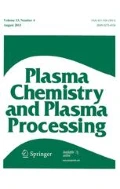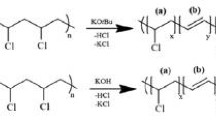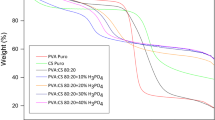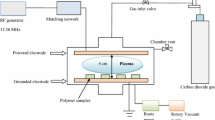Abstract
A poly(vinyl chloride) (PVC) membrane was exposed to atmospheric-pressure dielectric barrier discharge and subsequently wet-chemically grafted with poly(acrylic acid) (PAA) and then consumed with poly(ethyleneimine) (PEI). The thus modified membrane was characterized by measurement of the static water contact angle, by scanning electron microscopy, infrared spectroscopy (ATR-FTIR), thermogravimetry (TGA) and electrolytic responses. The TGA favors a thermally stable grafted PVC membrane. The ATR-FTIR revealed the existence of an ultra-thin PAA layer grafted onto the surface of the plasma-modified PVC membrane. The ion exchange capacity measurement of the grafted poly(vinyl chloride) (PVC–PAA) sample was close to that of additionally wet-chemically aminated with PEI for 12 h or more (PVC–PAA–PEI). It means that PVC–PAA membranes do not need necessarily further modifications. As concomitant helpful effect, it was observed that the swelling degree of the PVC membrane was reduced after plasma exposure due to plasma-induced crosslinking.













Similar content being viewed by others
References
Kamoun EA, Youssef ME, Abu-Saied MA, Fahmy A, Khalil HF, Abdelhai F (2015) Ion conducting nanocomposite membranes based on PVA-HAHAP for fuel cell application: iI. Effect of modifier agent of PVA on membrane properties. Int J Electrochem Sci 10:6627
Venkatesan PN, Dharmalingam S (2017) Characterization and performance study of phase inversed Sulfonated Poly Ether Ether Ketone–Silico tungstic composite membrane as an electrolyte for microbial fuel cell applications. Renew Energy 102:77
Tseng CY, Ye YS, Cheng MY, Kao KY, Shen W-C, Rick J, Chen J-C, Wang B-J (2011) Sulfonated polyimide proton exchange membranes with graphene oxide show improved proton conductivity, methanol crossover impedance, and mechanical properties. Adv Energy Mater 1:1220
Fu YZ, Manthiram A, Guiver MD (2007) Acid–base blend membranes based on 2-amino-benzimidazole and sulfonated poly(ether ether ketone) for direct methanol fuel cells. Electrochem Commun 9:905
Jiang Z, Zhao X, Fu Y, Manthiram A (2012) Composite membranes based on sulfonated poly(ether ether ketone) and SDBS-adsorbed graphene oxide for direct methanol fuel cells. J Mater Chem 22:24862
Wang J, Liao J, Yang L, Zhang S, Huang X, Ji J (2012) Highly compatible acid–base blend membranes based on sulfonated poly(ether ether ketone) and poly (ether ether ketone-alt-benzimidazole) for fuel cells application. J Membr Sci 415–416:644
Jiang Z, Jiang Z-J (2014) Plasma techniques for the fabrication of polymer electrolyte membranes for fuel cells. J Membr Sci 456:85
Follain N, Roualdes S, Marais S, Frugier J, Reinholdt M, Durand J (2012) Water transport properties of plasma-modified commercial anion-exchange membrane for solid alkaline fuel cells. J Phys Chem C 116:8510
Reinholdt M, Ilie A, Roualdès S, Frugier J, Schieda M, Coutanceau C, Martemianov C, Flaud V, Beche E, Durand J (2012) Plasma membranes modified by plasma treatment or deposition as solid electrolytes for potential application in solid alkaline fuel cells. Membranes 2:529
Navarro A, delRío C, Acosta JL (2009) Pore-filling electrolyte membranes based on plasma-activated microporous PE matrices and sulfonated hydrogenated styrene butadiene block copolymer (SHSBS) Single cell test and impedance spectroscopy in symmetrical mode. Solid State Ionics 180:1505
Bébin P, Caravanier M, Galiano H (2006) Nafions/clay-SO3H membrane for proton exchange membrane fuel cell application. J Membr Sci 278:35
Unger WES, Swaraj S, Oran U (2006) Radio frequency (r.f.) plasma-deposited polymer films: influence of external plasma parameters as viewed by comprehensive in situ surface chemical analysis by XAS, XPS and ToF-SIMS. Surf Interface Anal 38:522
Scheltjens G, Ponte GD, Paulussen S, de Graeve I, Terryn H, Reniers F, van Asche G, van Mele B (2015) Thermal properties of plasma deposited methyl methacrylate films in an atmospheric DBD reactor. Plasma Process Polym 12:260
Fridman A (2008) Plasma chemistry. Cambridge University Press, New York
Pelaz B, del Pino P, Maffre P, Hartmann R, Gallego M, Rivera-Fernández S, de la Fuente JM, Nienhaus GU, Parak WJ (2015) Surface functionalization of nanoparticles with polyethylene glycol: effects on protein adsorption and cellular uptake. ACS Nano 9:6996
Lei S, Wang X, Li B, Kang J, He Y, George A, Ge L, Gong Y, Dong P, Jin Z, Brunetto G, Chen W, Lin Z-T, Baines R, Galvao DS, Lou J, Barrera E, Banerjee K, Vajtai R, Ajayan P (2016) Surface functionalization of two-dimensional metal chalcogenides by Lewis acid − base chemistry. Nat Nanotechnol 11:465
Biederman H, Slavínská D (2000) Plasma polymer films and their future prospects. Surf Coat Technol 125:371
De Vietro N, Belforte L, Lambertini VG, Fracassi F (2014) Low-pressure plasma modified polycarbonate: a transparent, low reflective and scratch resistant material for automotive applications appl. Surf Sci 307:698
Nisol B, Batan A, Dabeux F, Kakaroglou A, De Graeve I, Van Assche G, Van Mele B, Terryn H, Reniers F (2013) Surface characterization of atmospheric pressure plasma-deposited allyl methacrylate and acrylic acid based coatings. Plasma Process Polym 10:564
Batan A, Brusciotti F, De Graeve I, Vereecken J, Wenkin M, Piens M, Pireaux JJ, Reniers F, Terryn H (2010) Comparison between wet deposition and plasma deposition of silane coatings on aluminium. Prog Org Coat 69:126
Vilani C, Weibel DE, Zamora RRM, Habert AC, Achete CA (2007) Study of the influence of the acrylic acid plasma parameters on silicon and polyurethane substrates using XPS and AFM. Appl Surf Sci 254:131
Weibel DE, Vilani C, Habert AC, Achete CA (2007) Surface modification of polyurethane membranes using low-powered gas plasmas. Influence on the pervaporation processes. J Membr Sci 293:124
Solouk A, Solati MH, Najarian S, Mirzadeh H, Seifalian AM (2011) Optimization of acrylic acid grafting onto POSS-PCU nanocomposite using response surface methodology. Iran Polym J 20:91
Fahmy A, Friedrich J (2013) Degradation behavior of thin polystyrene films under exposure to Ar-plasma and its emitted radiation. J Adhes Sci Technol 27:324
Desmet T, Morent R, Geyter N, Leys C (2009) Nonthermal plasma technology as a versatile strategy for polymeric biomaterials surface modification: a review. Biomacromol 10:2351
Keshvari H, Mirzadeh H, Mansoori P (2008) Collagen immobilization onto acrylic acid laser-grafted silicone for using as artificial skin: in vitro. Iran Polym J 17:171
Perni S, Kong MG, Prokopovich P (2012) Cold atmospheric pressure gas plasma enhances the wear performance of ultra-high molecular weight polyethylene. Acta Biomater 8:1357
D’Sa RA, Burke GA, Meenan BJ (2010) Protein adhesion and cell response on atmospheric pressure dielectric barrier discharge-modified polymer surfaces. Acta Biomater 6:2609
Shao T, Zhang C, Long K, Zhang D, Wang J, Yan P, Zhou Y (2010) Surface modification of polyimide films using unipolar nanosecond-pulse DBD in atmospheric air. Appl Surf Sci 256(12):3888
Morent R, De Geyter N, van Vlierberghe S (2011) Influence of operating parameters on plasma polymerization of acrylic acid in a mesh-to-plate dielectric barrier discharge. Prog Org Coat 70:336
Sardella E, Favia P, Dilonardo E, Petroni L, d´Agostino R (2007) PE-CVD of Acid/base coatings from acrylic acid and allylamine vapours. Plasma Process Polym 4:S781
Manley TC (1943) The electric characteristics of the ozonator discharge. Trans Electrochem Soc 84(1):83
Kogelschatz U (2002) Dielectric-barrier discharges: their history, discharge physics and industrial applications. IEEE Trans Plasma Sci 30(4):1400
Zainoodin AM, Kamarudin SK, Masdar MS, Daud WRW, Mohamad AB, Sahari J (2014) High power direct methanol fuel cell with a porous carbon nanofiber anode layer. J Appl Energy 113:946
Yang C, Chiu S, Kuo S (2011) Preparation of poly (vinyl alcohol)/montmorillonite/poly (styrene sulfonic acid) composite membranes for hydrogen–oxygen polymer electrolyte fuel cells. J Curr Appl Phys 11:229
Hasan M, Narayan A, Lee M (2015) Enhanced thermo-optical performance and high BET surface area of graphene PVC nanocomposite fibers prepared by simple facile deposition technique: N2 adsorption study. J Ind Eng Chem 21:828
Elamathi S (2010) Synthesis and characterization of polymer electrolyte membranes for fuel cell application, chapter two. Ph.D., Anna University, Chennai-Madras, India
Abu-Saied M, Fontananova E, Drioli E, Mohi Eldin MS (2013) Sulphonated poly(glycidyl methacrylate) grafted cellophane membranes: novel application inpolyelectrolyte membrane fuel cell (PEMFC). J Polym Res 20(7):1
Brandenburg R (2017) Dielectric barrier discharges: progress on plasma sources and on the understanding of regimes and single filaments. Plasma Sources Sci Technol 26:053001
Fahmy A, Schönhals A (2016) Reaction of CO2 gas with (radicals in) plasma polymerized acrylic acid (and formation of COOH-rich polymer layers). Plasma Process Polym 13:499
Villegas M, Romero AI, Parentis ML (2016) Acrylic acid plasma polymerized poly(3-hydroxybutyrate) membranes formethanol/MTBE separation by pervaporation. Chem Eng Res Des 109:234
Fahmy A, Debarnot D, Friedrich J (2015) Influence of water addition on the structure of plasma-deposited allyl alcohol polymer films. J Adhes Sci Technol 29(10):965
Fahmy A, Friedrich J, Poncin-Epaillard F, Debarnot D (2016) Plasma polymerized allyl alcohol/O2 thin films embedded with silver nanoparticles. Thin Solid Films 616:339
Rezaei F, Shokri B, Sharifian M (2016) Atmospheric-pressure DBD plasma-assisted surface modification of polymethyl methacrylate: a study on cell growth/proliferation and antibacterial properties. Appl Surf Sci 360:641
Merche D, Poleunis C, Bertrand P (2009) Synthesis of polystyrene thin films by means of an atmospheric-pressure plasma torch and a dielectric barrier discharge. IEEE Trans Plasma Sci 37(6):951
Del Fanti NA (2008) Infrared spectroscopy of polymer. Thermo Fisher Scientific Inc., Waltham
Fahmy A, Eisa WH, Yosef M, Hassan A (2016) Ultra-thin films of poly(acrylic acid)/silver nanocomposite coatings for antimicrobial applications. J Spectrosc 2016:1
Mahfoudh A, Barbeau J, Moisan M, Leduc A, Seguin J (2010) Biocidal action of ozone-treated polystyrene surfaces on vegetative and sporulated bacteria. Appl Surf Sci 256(10):3063
Fahmy A, El-Nasser KS, Ali IO, Salama TM, Altmann K, Friedrich JF (2017) Tuning of adhesion of silver nanoparticles onto zeolite ZSM-5 using electrospray ionization (ESI) encapsulation with poly (acrylic acid). J Adhes Sci Technol 31(24):2641
Fahmy A, Mohamed TA, Friedrich JF (2018) XPS and IR studies of plasma polymers layer deposited from allylamine with addition of ammonia. Appl Surf Sci 458:1006
Morent R, De Geyter N, Trentesaux M, Gengembre L, Dubruel P, Leys C, Payen E (2010) Stability study of polyacrylic acid films plasma-polymerized on polypropylene substrates at medium pressure. Appl Surf Sci 257:372
Edwards HGM, Brown DR, Dale JA, Plant S (2000) Raman spectroscopy of sulphonated polystyrene resins. J Vib Spectrosc 24:213
Mohanapriya S, Bhat SD, Sahu AK, Manokaran A, Vijayakumar R, Pitchumani S, Sridhar P, Shukla AK (2010) Sodium-alginate-based proton-exchange membranes as electrolytes for DMFCs. Energy Environ Sci 3:1746
Maiti J, Kakati N, Lee SH, Jee SH, Viswanathan B, Yoon YS (2012) Where do poly(vinyl alcohol) based membranes stand in relation to Nafion® for direct methanol fuel cell applications? J Power Sources 216:48
Author information
Authors and Affiliations
Corresponding authors
Additional information
Publisher's Note
Springer Nature remains neutral with regard to jurisdictional claims in published maps and institutional affiliations.
Rights and permissions
About this article
Cite this article
Abu-Saied, M., Fahmy, A., Morgan, N. et al. Enhancement of Poly(vinyl chloride) Electrolyte Membrane by Its Exposure to an Atmospheric Dielectric Barrier Discharge Followed by Grafting with Polyacrylic Acid. Plasma Chem Plasma Process 39, 1499–1517 (2019). https://doi.org/10.1007/s11090-019-10017-6
Received:
Accepted:
Published:
Issue Date:
DOI: https://doi.org/10.1007/s11090-019-10017-6




